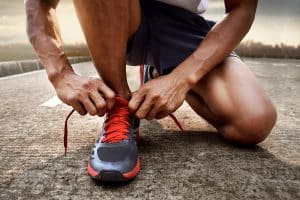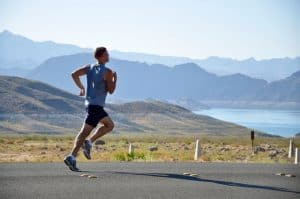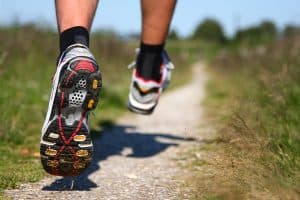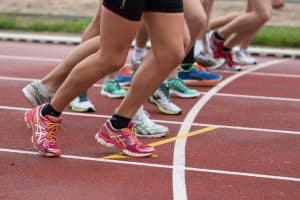
With thousands of running shoes on the market, it can be overwhelming narrowing down to the one pair that will enhance your runs. To make the process easier, you want to take the time to learn about your running style and running shoes in general. With this information, it makes it easier to narrow down the best shoes for you so that you can try them on and purchase the perfect pair.
Types of Running
There are three primary types of running. Getting the facts about these and the best shoe features for your preferred running style makes the process of choosing the right shoe easier.

Road running: This involves running in urban environments, such as on concrete sidewalks and asphalt roads. Lightweight shoes comprised of nylon mesh or nylon, synthetic leather and breathable materials are ideal. Look for extra cushioning in the midsole, a blown rubber forefoot and carbon rubber heel. The heel to toe drop should be under eight millimeters – to encourage “midfoot” striking instead of heel striking (more on that later.)

Trail running: This is for trails, often made of dirt, rocks and other natural materials. There are five primary characteristics to look for in a good trail running shoe. You need good tread to ensure traction. If you run on rocky trails, look for outsoles with sticky rubber for optimal traction. On tighter packed dirt, lugs spaced two to four millimeters apart is ideal. You also need solid cushioning to absorb impact, a heel to toe drop of 10 to 12 millimeters [1], rock plate to reduce the risk of rock bruising and waterproof features.

Racing: Racing is generally short distances and competitive. Good forefoot and heel cushioning is important for those racing because it helps to absorb impact, but at the same time, you want a shoe that is ultra-lightweight so that it does not slow you down. Other important racing shoe features include breathability, motion control, good traction and flexibility so your foot is not restricted.
Anatomy of a Running Shoe
There are multiple components that make up a running shoe. Knowing what these are makes it easier to determine which shoe has what you need for your preferred running style. These components include:
- Outsole: This element serves as the base of your shoe. It provides traction and allows you to make contact with the surface you are running on. At key stress points on your shoe, there may be overlay reinforcing strips to provide additional shoe structure.
- Insole: The insole is soft, but firm. It helps to provide some shock absorption every time your foot strikes the ground. It also helps to support the contours of your foot.
- Sock liner: This is on the inside of the shoe and the foot sits directly on it. It helps to ensure the shoe fits properly.
- Midsole: This sits above the outsole, but above the upper. It helps to protect against impact when your foot hits the ground. It is usually comprised of polyurethane or EVA foam, but some shoes use a gel. The gel may increase protection and durability.
- Upper: This element of a shoe encases the foot. It should leave a little room but should also gently hug the foot.
- Heel counter: This component is on the back of the shoe. It helps to increase support and reinforce the cup of the heel. It should be firm since it plays a major role in controlling foot pronation when you are running.
- Tongue: This is a soft flap on the top of the shoe. It protects against the pressure that shoe laces can put on blood vessels and tendons in the foot.
- Quarter panel: These are the sides of the shoe. They can be vented to help reduce foot sweat when wearing the shoes.
- Collar: This area of the shoe is inside the back area. It allows for support and comfort for your ankle.
- Heel collar: This is in the back of the shoe. It provides additional heel support and conforms to your heel.
- Heel tab: This is the small tab at the top of the heel of the shoe. It keeps the heel in place when you are running and provides some protection for the Achilles tendon.
- Eyelets: These are the holes that you run the strings through.
- Lasting: This is the material that is attached to the upper. This helps to reinforce the upper and plays a role in differentiating among running shoe types.
- Space trusstic: This is below the shoe’s arch section and is a type of plastic bridge. It gives the shoe stability and strength without causing it to lose flexibility.
When looking at shoes, you also want to explore the heel to toe drop. This is best defined as the difference between the forefoot height and heel height. For example, if the drop is 12 millimeters, this means that the compared to the forefoot, the heel sits 12 millimeters higher. When you are running, the lower this drop, the easier it is to land on your forefoot or midfoot when you are running.
Midfoot striking is another concern. This means landing on the area of the foot right behind the ball of the foot. This allows for a softer landing and less impact on the foot structures. [2] To achieve midfoot striking takes practice and starts with a lightweight running shoe. Other ways to achieve this strike include shortening your stride, ensuring proper posture and strengthening the lower leg muscles.
Check Your Pronation
Pronation refers to the natural movement of your body concerning how your foot rolls inward upon landing for impact distribution. Your pronation is something you must know to choose the right running shoe. If your ankle rolls too far inward and downward, this is overpronation. During a step, if the ankle rolls too far outward, this is underpronation (supination). Consider the following when choosing running shoes based on pronation:
- Those with underpronation should look for shoes with extra cushioning to reduce the risk of impact injuries. You might consider neutral shoes.
- Those with overpronation want structured and cushioning soles for extra support and stability control. You might consider motion control [3] or stability shoes.
- Those with neutral pronation can wear just about any running shoe that fits their preferred style and preferences. You might consider minimalist, neutral or barefoot shoes.
The midfoot strike tends to be preferred by experienced and elite runners compared to the heel strike because it is gentler on the feet, ankles and lower legs. [4]
How to Make the Right Choices
Looking at a few common running scenarios helps you to see how specific runners go about choosing a shoe.
Scenario one: You are a road runner and you are seeking a neutral shoe that supports a midfoot strike and long-distance running. Since this type of running is done on hard surfaces, extra cushion at the midsole promotes comfort since it absorbs more shock. The sole should be rubber (blown at the forefoot and carbon at the heel) and offer sufficient traction for days when you are running on wet roads. [5]
Scenario two: You are a trail runner looking for the perfect shoe. You want a shoe that has a rock plate, significant tread for traction, a heel to toe drop of 10 to 12 millimeters and waterproof features.
Scenario three: You are a race runner needing a shoe that allows you to compete at your best. One of the most important attributes is the shoe needs to be ultra-lightweight and flexible. Racing shoes should also have motion control, breathability and good traction.
Tricks and Tips for Finding the Right Running Shoes
In addition to everything you have just learned, there are a few extra tips to make finding the perfect running shoe simpler:
- Your feet swell during the day, making them approximately a size larger in the evening, so it is best to shop for shoes later in the day
- Look for gait issues by checking the wear pattern on your shoes. This helps you to determine if your pronation needs to play a role in your choice
- Wear your running socks when buying running shoes to make sure they fit well together
- Have your feet measured by a professional to get your exact size (this includes both length and width)
- Consider your body type since larger bodies tend to need more cushioning for adequate shock absorption
- Look at the arch of your foot. A higher arch tends to prefer flexible, neutral shoes while low arches tend to need a more stable shoe
With this information, buying your next pair of running shoes will be a much more enjoyable and smooth experience. Just make sure to replace your shoes on time so that you are getting the full benefit of what your shoes offer your runs.
References
[1] https://bjsm.bmj.com/content/early/2015/07/28/bjsports-2015-095054.short?rss=1
[2] https://journals.lww.com/acsm-msse/Fulltext/2004/02000/Reduced_Eccentric_Loading_of_the_Knee_with_the.15.aspx
[3] https://www.tandfonline.com/doi/abs/10.1080/02640414.2011.591420
[4] https://www.ncbi.nlm.nih.gov/pmc/articles/PMC4801105/
[5] http://citeseerx.ist.psu.edu/viewdoc/download?doi=10.1.1.427.6698&rep=rep1&type=pdf


Tim is the founder of FitAtMidlife.com – an avid gym rat for 30+ years, he’s a reviewer of many, many shoes – and founder of the Speed Bag Gathering – the world’s only gathering of speed bag punching enthusiasts. See more gym reviews at Tim’s YouTube channel.
